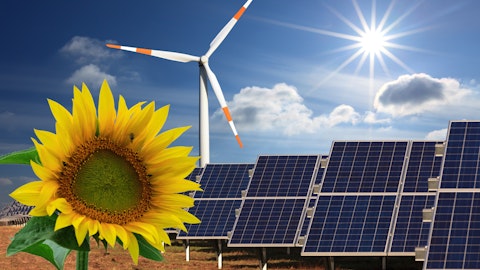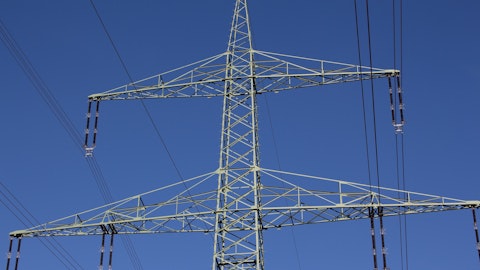Public Service Enterprise Group Incorporated (NYSE:PEG) Q4 2022 Earnings Call Transcript February 21, 2023
Operator: Ladies and gentlemen, thank you for standing by. My name is Shamali and I am your event operator today. I would like to welcome everyone to today’s conference, Public Service Enterprise Group’s Fourth Quarter and Full Year 2022 Earnings Conference Call and Webcast. At this time, all participants are in a listen-only mode As a reminder, this conference is being recorded today, February 21, 2023, and will be available for replay as an audio webcast on PSEG’s Investor Relations website at investor.pseg.com. I’d now like to turn the conference over to Carlotta Chan. Please go ahead.
Carlotta Chan: Thank you, Shamali. Welcome to PSEG’s fourth quarter and full year 2022 earnings presentation. Joining us on the call today are Ralph LaRossa, Chair, President and CEO of PSEG; and Dan Cregg, Executive Vice President and CFO. The press release attachments and slides for today’s discussion are posted on our IR website at investor.pseg.com and our 10-K will be filed shortly. The earnings release and other matters discussed during today’s call contain forward-looking statements and estimates that are subject to various risks and uncertainties. We will also discuss non-GAAP operating earnings, which differs from net income or net loss as reported in accordance with generally accepted accounting principles in the United States.
We include reconciliations of our non-GAAP financial measures and a disclaimer regarding forward-looking statements on our IR website and in today’s material. Following Ralph and Dan’s prepared remarks, we will conduct a question-and-answer session. I will now turn the call over to Ralph.
Ralph LaRossa: Thank you, Carlotta, and thank you to everyone joining us on our call this morning. Since the third quarter 2022 earnings report, we’ve had several important updates. Dan will provide you with a full financial review later in our prepared remarks as I will focus on some strategic highlights. We are pleased to report strong operating and financial results for both the fourth quarter and full year of 2022. We successfully navigated last year’s challenges including inflation, supply chain disruptions, energies price spikes, and the steep rise in interest rates to deliver a GAAP earnings of $2.06 per share, and non-GAAP operating earnings of $3.47 per share, placing our results for the full year above the midpoint of our 2022 non-GAAP earnings guidance.
In fact, 2022 was the 18th year in a row that PSEG has delivered non-GAAP results at or above management’s original operating earnings guidance. PSE&G which contributed the vast majority of our results posted in 8.2% annual increase in net income from the continued investment in its TND infrastructure, clean energy programs and a first full year of decoupling. PSE&G invested over $3 billion of capital during 2022 in transmission upgrades, gas system modernization, energy efficiency, electric vehicle infrastructure and launched our efforts to address the reliability of the last mile of our distribution system. At year end 2022, PSE&G’s rate base topped $26.4 billion a 7.7% increase over the year end 2021. We know the importance shareholders placed on a predictability and visibility of our financial results and during the past 12 months we have taken many steps to deliver just that.
First, we completed the strategic alternatives process, which included the sale of PSE&G fossil last February. This increased the regulated contribution to about 90% of our consolidated non-GAAP earnings. We completed a $500 million share repurchase program in May of 2022 and increased the cash return to shareholders by raising the annual dividend by $0.12 or 5.9% for 2022. Second, the passage of the inflation reduction act of 2022 will offer our nuclear generation a level of much needed stability when it goes into effect in 2024. While the industry waits for clarifications, we believe the inflation reduction act is a game changer that should provide the stability required for long term financial viability of the U.S. nuclear fleet. As a result of the nuclear production tax credits extending through at least 2032 we are now able to consider small but important value added investments, including the potential for capacity upgrades to a fuel cycle extension to hold Creek and the license extension of our New Jersey units.
Critical to these decisions will be our determination of how predictable and visible nuclear revenues could be beyond our current three years ZEC window. The Ira also created valuable incentives for PSE&G’s customers to accelerate their transition to electric vehicles, which will advanced New Jersey’s decarbonisation goals and expand our opportunities to invest in last mile reliability and make ready infrastructure. This aligns with the recent state objectives to increase electrification. Just last week, Governor Murphy issued three executive orders that establish or accelerate the state’s existing 2050 targets for clean source energy, building electrification and electric vehicle adoption goals with new target dates in 2030 and 2035. The Board of Public Utilities and other state agencies were directed to collaborate with stakeholders to develop plans to reach these goals.
These include an updated energy master plan in 2024, and a new proceeding to develop a future of natural gas utility plant to consider new revenue streams, such as conversion of existing facilities to district geothermal, and new technologies to meet the 2019 energy master plan goal of 50% reduced emissions below 2006 levels by 2030. Third, we announced our strategic decision to exit our investment in offshore wind generation by selling our 25% equity stake in Ocean Wind 1 backdoor joint venture partner Ãrsted. This decision to exit or short generation was consistent with our goal to increase the predictability of our business. PSE&G will continue to provide Ocean Wind 1 to onshore construction management services to ensure the onshore substations and associated onshore cabling are ready to receive the project’s output when it goes in service.
We also intend to continue pursuing regulated transmission projects offshore and investing in related transmission and distribution projects onshore and enabling the New Jersey wind port in Salem County. Finally, last week, the BPU approved the settlement of our pension accounting filing, retroactive to January 1, 2023. An important step we have pursued to limit pension expense volatility. This improved business platform created by the strategic actions we have taken over the past two years, combined with our efforts to increase the predictability of our results, positions us to narrow our 2023 non-GAAP operating earnings to a range of $3.40 to $3.50 per share from our original guidance of $3.35 to $3.55 a share provided last November. This new $0.10 range compares to the $0.20 range we have provided in previous years.
These strategic rules also drive our outlook for long term compound annual earnings growth rate of 5% to 7% through 2027 and enable us to pursue this growth path without the need to issue new equity during this five year period. Moving into 2023, we extended our 2022 dividend increase of $0.12 per share to set the 2023 indicative annual rate at $2.28 per share, marking our 116th year of paying a dividend to shareholders. PSE&G has begun executing its capital investment plan of over $3.4 billion for 2023 which is expected to be the largest single year spend in utilities 120 year history. This will be directed primarily towards infrastructure replacement, energy efficiency and last mile reliability. The good news is that additional headroom was created in our gas and combined customer bill, as the recent decline in natural gas prices has enabled PSE&G to reduce its residential default gas supply rate by $0.15 to $0.15 per therm for the balance of the winter 2020 to 2023 heating season.
This decrease in the pastor commodity charge will reduce the typical residential winter gas bill by $13 per month annualized or 11.5%. Speaking of our customers, they rated PSE&G number one in 2022 JV Power customer satisfaction studies for both residential electric and natural gas service in the East among large utilities. This is the first time we have achieved both number one rankings in the same year. This honor culminated the year that saw PSEG recognized by the Edison Electric Institute with the Edison award, the industry’s highest honor, for leadership and innovation. And speaking of leadership, PSEG’s environmental, social and governance credentials continue to be recognized. In addition to our MSCI upgrades to triple A, its highest ESG rating PSEG was also named for the Dow Jones Sustainability North America index for the 15th year in a row, as well as just 100 list of America’s most just companies for 2023 recognizes our commitment to serving our customers, workforce, communities, the environment and shareholders.
None of this could be accomplished without our employees, who remain PSEG’s most important resource. Together, we continue to be guided by PSEG’s long standing commitment to operational excellence, discipline, investment, and financial strength. As I recognize our employees, I must take a moment to honor one that lost his life in a tragic act of violence. Some of you may have heard about the horrible loss when a member of the PSEG team was killed by a former employee. It was one of the saddest days in our company’s history. Our condolences and prayers go out to all of those that have been impacted by this event. I also want to thank our employees who supported each other during this difficult time. We will continue to provide resources to protect the health, safety and wellbeing of all PSEG employees, including grief counseling for any employee seeking it.
In closing, and as I mentioned earlier, we know the important stakeholders play some predictability and visibility of our financial results and goals. I have made increasing both factors, a key focus of PSEG’s strategic plan. We intend to share the details of this plan on our upcoming investor conference on March 10 as we continue to build a practical path for decarbonizing the New Jersey economy. I’ll now turn the call over to Dan and return after his remarks for Q&A.
Dan Cregg: Thank you, Ralph. Good morning everybody. For the full year 2022 GAAP earnings were $2.06 per share, compared to a GAAP loss of $1.29 per share for the full year of 2021, which included fossil sale related impairments. Non-GAAP results for $3.47 per share for 2022 compared to 2021’s non-GAAP results of $3.65 per share, which you may recall excluded depreciation related to the fossil assets held for sale in the fourth quarter of ’21 and retirement of power debt. For the fourth quarter of 2022 GAAP earnings improved to $1.58 per share, compared with $0.88 per share for the fourth quarter of 2021. Non-GAAP operating earnings were $0.64 per share compared with $0.69 per share for the fourth quarter of 2021 which contain the fossil sale related items I just mentioned.
We provided information on slides 9 and 11 regarding the contribution to non-GAAP operating earnings by business on the fourth quarter and full year periods ended December 31. Slides 10 and 12 contain waterfall charts that take you through the net changes quarter-over-quarter and year-over-year and non-GAAP operating earnings by major business which I will review now starting with PSE&G. Full year 2022 net income rose by $119 million or over 8% to $1.565 billion compared to 2021 net income of $1.446 billion reflecting higher earnings from continued investment in TND programs and the favorable impact of a full year of decoupling in 2022. For the fourth quarter of 2022, the utilities net income rose by $81 million to $352 million or $0.70 per share compared to $0.53 per share in the fourth quarter of 2021.
As you can see on Slide 10 transmission margin and a penny per share compared to the year earlier quarter, reflecting growth and rate base partly offset by the timing of O&M recovery. Gas, electric and other margin contributed combined to add $0.07 per share compared with last year’s fourth quarter reflecting GSMP II roll-ins the Conservation incentive program or CIP decoupling for both electric and gas, appliance service and other margins. On the expense side, O&M was flat versus the prior year quarter. Higher distribution depreciation and interest expense each reduce results by a penny per share reflecting higher plant in service and investment. Lower pension expense added a penny per share versus a year ago quarter and flow through taxes the impact of lower outstanding shares and other items added $0.10 per share compared to the fourth quarter of ’21 with $0.07 of that amount reversing the timing impact of taxes from prior quarters in 2022.
During ’22, PSEG invested over $3 billion in planned capital spending to upgrade transmission and distribution facilities, enhance reliability and increased resiliency. In 2022, we also launched the IAP our $511 million infrastructure advancement program, which the BPU authorized last June to improve the reliability of the last mile of our electric distribution system and address aging substations and gas M&R stations. As Ralph mentioned a year in 2022 PSE&G’s rate base stood at approximately $26.4 billion a 7.7% increase over year end 2021. Last Friday, the Board of Public Utilities approved an order authorizing PSE&G to modify its method of pension accounting for ratemaking purposes, which will mitigate variability in the calculation of PSE&G’s pension expense for calendar year 2023 and beyond.
The backdrop of economic conditions continue to improve in New Jersey during 2022. New Jersey’s unemployment rate return to pre-pandemic levels of 3.3% in September, and remain below the national average at year end. System peak load reached 10,147 megawatts on August 9, exceeding the 10,000 megawatt level for the second year in a row. Weather normalized electric sales increased by 2% for the year with residential sales flat and CNI sales increasing by 3%. Weather normalize gas sales were flat for the year with residential gas sales down 1% while CNI sales increased by 2%. mechanism because the impact of most customer usage from margin subject to earnings or rate cap limitations, leaving the change in the number of customers as the major driver of margin growth going forward.
The number of electric and gas customer rose by approximately 1% each in 2022. Wrapping up the utility update. We’ve narrowed our forecast of PSE&G’s net income for 2023 To $1.5 billion to $1.525 billion which reflects pension and OPEB updates compared to 2022 offset by the benefit of contemporaneously recovered investments, predictability of utility margin from the safety coupling, as well as the implementation of the pension accounting filing effective for calendar year ’23. Now turning to carbon free infrastructure another. For full year 22 CFIOs net loss of $534 million or $1.06 per share reflected higher losses on both mark to market transactions and nuclear decommissioning trust fund related activity. The full year 2021 net loss included impairments and debt extinguishment costs related to the fossil sale.
Non-GAAP operating earnings declined $174 million or $0.35 per share from $407 million for full year ’21 reflecting the absence of the fossil assets. The fourth quarter 22 CFIOs net income improved to $436 million or $0.88 per share from $174 million in the year ago quarter, reflecting higher gains on both mark to market transactions and NDT fund related activities. Net income for the fourth quarter 21 included debt extinguishment costs and other charges related to the sale of fossil. For the fourth quarter 2022 the non-GAAP operating earnings loss of $34 million or $0.06 per share reflected the absence of the fossil assets compared to the fourth quarter 2021 non-GAAP earnings of $81 million or $0.68 per share, which reflected the cessation of depreciation and lower interest costs related to the fossil sale.

Photo by Austin Distel on Unsplash
Referring again to Slide 10, non-GAAP operating earnings were $0.22 per share lower in the fourth quarter than the fourth quarter of 2021 driven by lower capacity prices for the remaining nuclear fleet, but regeneration volume recontracting lower prices and lower deck revenue compared to the year ago quarter. Combined these items drove electric gross margin to decline $0.34 per share. Gas operations improved by $0.04 per share, reflecting higher off system sales, higher commodity pricing and higher stores. Power related cost comparisons for the fourth quarter 2022 improve his overall O&M expense was $0.07 per share favorable compared to the year ago quarter. Again reflecting fossil assets sale, partly offset by the plan refueling at the 100% owned Hope Creek nuclear plant in this year’s fourth quarter.
Appreciation and interests were higher by a penny per share that reflected the March 2022 debt issuance of power versus the year earlier debt retirements related to the fossil sale. Activity was a pay per share favorable compare the fourth quarter of 2021 primarily reflecting the essence of 2021’s donation to the PSEG foundation, partly offset by higher parent interest of $0.04. Taxes and other improved by a penny per share over the fourth quarter of 2021 and includes the accelerated receipt of expected tax carried out claim in ’22 instead of ’23, which is partially offset by the reversing of a timing impact from tax benefits in prior quarters in 2022. Turning to ops. The nuclear fleet operated and an average capacity factor of 85.8% during the fourth quarter, which included the Hope Creek and 7.3 terawatt hours requirement for generation.
An unplanned outage at Salem unit two in late December 2022 occurred during a PJM region wide generation emergency action and resulted in capacity performance penalties. The net financial impact of the outage including replacement power, capacity penalties, as well as bonuses earned by the other operating PSEG units did not expect it to be material. For the full year the nuclear fleet operated at an average capacity factor of 92.2% producing 31.3 terawatt hours of generation. PSEG’s forecasting total baseline baseload nuclear generation of approximately 31 terawatt hours for the full year of 23 hedged 95% to 100% and an average price of $31 per megawatt hour an increase of about $4 per megawatt hour compared to ’22. For ’24 total nuclear generation is forecast also to be approximately 31 terawatt hours, and 55% to 60% hedged than an average price of $32 per megawatt hour.
In addition, in December, we exited certain legacy BGS or basic generation service contracts in order to rebalance our hedge portfolio and realign it to our baseload nuclear fleet and reduce volatility in 2023. Wrapping up CFIO we’ve narrowed our forecast of non-GAAP operating earnings to $200 million to $225 million from $185 million to $235 million. A quick update on financing activity and collateral postings. As of December 31, 2022, total available credit capacity was $3.7 billion including a billion at PSE&G. In addition, we have total cash and cash equivalents on hand of approximately $465 million. PSEG power had net cash collateral postings of $1.5 billion at December 31 primarily related to as a money hedge positions resulting from higher energy prices, which declined to $700 million through last Friday.
Given the recent improvement in our collateral position, in January of this year, we prepaid $750 of a $1.5 billion short term loan that was due in April. Following the repayment of this term loan, PSEG had outstanding a total of $1.25 billion of 365 day term loans expiring this spring to support powers collateral needs and power had an outstanding a $1.25 billion term loan expiring in March of 2025. Combined, these term loans comprise $2.5 billion a variable rate debt. As we mentioned during our third quarter call, we entered into interest rate swaps during September and October of last year, which converted $1.05 billion of our outstanding term loans from floating to fixed rate reducing our variable rate debt exposure. Following the measurement of the pension at year end 2022, we’ve incorporated the impact of the actual 2022 investment returns, discount rate and interest rates into the 2023 pension .
Our expected return on plan assets increased to 8.1% for 2023, as the declining value of the fixed income securities due to higher interest rates during ’22 enables a higher yield on them going forward. While 2022 investment returns has a negative impact on 2023 pension calculations, the increase in interest rates serves to reduce the pension liability with the funded status of a pension plan, ending the year at a solid 87%. In addition, the county settlement approved by the BPU will create a regulatory asset or liability to overlay our current accounting, which will partly mitigate the impact of certain expense related pension calculations going forward. As Ralph mentioned earlier, we’ve narrowed our 2023 non-GAAP operating earnings guidance to $3.40 to $3.50 per share around the same $3.45 per share midpoint, with regulated operations continuing to contribute approximately 90% of that total.
As a reminder, PSEG does not forecast GAAP earnings related and related long term growth rates. PSE&G’s forecast of 2023 net income is narrowed to $1.500 billion to $1.525 billion reflecting the predictability provided by the expected transmission distribution investment recovery, and focus on owned and cost control. Non-GAAP operating earnings guidance for CFIO is now forecasted at $200 million to $225 million. CFIOs narrowed guidance also removed the previously expected benefits of the tax carry back claim from PSEG’s 2023 operating guidance. That concludes our prepared remarks. So Shamali please open the line. And we’ll take some questions.
See also 11 High Growth Utility Stocks to Buy and 10 Tech Stocks To Sell Now According to Cathie Wood.
Q&A Session
Follow Public Service Enterprise Group Inc (NYSE:PEG)
Follow Public Service Enterprise Group Inc (NYSE:PEG)
Operator: Thank you. Ladies and gentlemen, we will now begin the question and answer session for members of the financial community. And the first question is from Shar Pourreza from Guggenheim Partners. Please proceed with your question.
Unidentified Analyst: Good morning Ralph and team. It’s actually Constantine here for Shar. Congrats on the quarter.
Ralph LaRossa: Hey –
Unidentified Analyst: Just wanted to start off with ’23 guidance updates, and specifically on the utility. Do you have any updates on the O&M cost initiative targets and interest costs that are embedded in guidance versus what was presented in November especially as you’re finding down some of the collateral needs. And just maybe to clarify, was the pension outcome the main driver for the 15 million decrease at the top end of the guidance?
Ralph LaRossa: I think the way to think about the tension honestly, is just reducing volatility overall, as we think about it EI was in November, we were providing guidance. And as you know, we snapped the tape at 12.31. And so I think the elimination of the ups and downs that could have come from year end, which was not known at the time was part of the reason that we had a wider range at that point and are more narrow now I would say that that number came in right about where we thought it was going to. And so I would say we are consistent with that. But with the absence of the movement that we could have had. We had presumed at that time, Constantine, that we would obtain what we did subsequently obtained from the BPU. So that was presumed already and I would say from an O&M perspective.
I’d say it’s fair to think about the assumptions as being consistent as what we said at EI. We may see some benefits coming through by virtue of collateral coming off a little quicker but the year is not over. We’ll continue to see some movements. And we’ll continue to manage that going forward.
Dan Cregg: Yes Constantine the only I would add from O&M standpoint, we would have been a culture of continuous improvement. And we’ll continue to look for opportunities when they arise, but we don’t normally publicize any specific numbers on that area.
Unidentified Analyst: Okay. Thanks for that clarification. This one might be more for Dan, again, with the, with the announced exit from offshore wind. And the first part being though that put option on the JV and the potential incremental acreage sales more directly? How are you thinking about the use of proceeds? And as we think about the old investment capacity slide, and with the sale proceeds the unwind of the short term financing? Is there a target FFO to debt metrics that we need to think about in your longer term planning assumptions?
Ralph LaRossa: Yes, I think, we sell on it that that exit from motion when one would be at our cost to date. And we’ve characterized it as being right around $200 million just in just an excess of $200 million, so that it certainly is nice to have back but it’s not a major item to move the needle with respect to the broader numbers. I think we’ve talked about having an overall as a footstep threshold 13% to 14%. And we’ve talked in the past about living somewhere north of that into the 15, 16 area. And I think that’s a fair way to continue to think about where we are.
Unidentified Analyst: Great, and maybe for just one second shifting to nuclear. What’s the threshold for including operational or CapEx driven upside into the plan and the needs associated with it, just thinking about co-owner and some of the assets of just being de-announcements around some of the upgrades elsewhere. Curious on any thoughts or conversations that you’ve had?
Ralph LaRossa: Yes. So we’ll have our normal run rate operating capital. And to the extent that there’s an opportunity to deploy capital to enhance results overall. Obviously, that analysis is going to go through just like any other analysis, we would do and be up against the hurdle rate that’s going to show that it’s going to make sense for us to do that. I think we have some promise on some things going forward. And maybe we’ll give you a little bit more color about that, as we get a little further down the road on it.
Unidentified Analyst: And any specific conversations that you’ve had or still too early?
Ralph LaRossa: About the CapEx?
Unidentified Analyst: With the co-owners.
Ralph LaRossa: We talk to our callers all the time. I mean, that’s just the normal operating but nothing specific. Yes.
Unidentified Analyst: Okay, thank you. Appreciate it. Thanks for taking the questions.
Operator: Our next question comes from the line of Jeremy Tonet with JPMorgan. Pleae proceed with your questions.
Unidentified Analyst: Hi, good morning. It’s actually Rich on for Jeremy. Can you hear me?
Ralph LaRossa: Sure. Yes.
Unidentified Analyst: Hey, thanks. circle back to the offshore we update just on the acreage. Any options here evaluating beyond an outright sale here? Also curious when we can expect the next update on this front?
Ralph LaRossa: Yes. So Rich, just unequivocally we’re not going to be in the offshore generation business. I mean that and the timing of what we do, we’ll just be keeping an eye on the market and see what makes sense.
Unidentified Analyst: Very clear. Got it. And then just Governor Murphy’s executive orders within that I guess the 100% clean energy plan. How do you see this impacting the Energy Master Plan overall and curious at a high level, what you’re focused on either from that front or from an EMP front?
Ralph LaRossa: So I would kind of say, there’s a lot of good news in that announcement last week for a company like ours, and especially one, it’s been focused. We kicked off this effort on the last mile last year and I think this just kind of reinforces the need for it from a customer standpoint, and from a reliability standpoint. So lots of opportunities. We’ll certainly be engaged in that. I personally am tripling down on electric vehicles as much as we can in this area, and that’s driving the decarbonisation in the state. And then from a gas system standpoint, certainly some push on whether or not there’s a lot of expansion of the gas system, we have about a high 80% saturation rate for our customers. So we never had our business plan set up for growth on the gas side.
That’s not in our numbers. We just kind of hook up customers, as they call this, but our replacement plans are completely aligned. If you look at the wording that’s in the executive order by reducing methane emissions. So we think there’s just a lot of positives in that announcement. And we’ll work with the state and policy makers on whatever we can self drive that in the Energy Master Plan.
Unidentified Analyst: Got it, very helpful it. Sorry, just wanted to circle back one last time to offshore wind to acreage. Is that is that all committed? And can you just run the numbers on what’s in there and what’s net to PEG?
Ralph LaRossa: It’s 35,000 acres, and so there’s about 35,000 acres that are still available to some degree, we’ve committed some of that are set if they go ahead skip check. I don’t have the exact numbers in front of us, but it’s a de minimis amount of that 35,000.
Dan Cregg: Yes, there’s, as that project was going forward, there was a need for some incremental acreage. And so some of those were made available for that purpose.
Unidentified Analyst: Great. Thank you for the time today.





